The Work of Terence and Dennis
An Appreciation of the McKenna Brothers
v1.1 - Mar 21, 2013

|
Silver-tongued and a riveting speaker,
he articulated the concepts that his fans
groped for but could not express,
and he did so in a witty, disarming way."
-- Dennis McKenna,
The Brotherhood of the Screaming Abyss, 2012
The Brotherhood of the Screaming Abyss, 2012
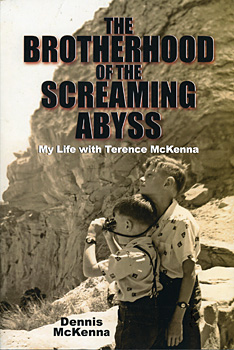
|
Dennis, who greatly admired his imaginative older brother, took on a different role in society, after the two intrepid explorers returned from the shamanic-alchemical-cosmic folie-a-deux described as "the experiment at La Chorrera" in their joint autobiography The Invisible Landscape. Dennis went back to school, got a PhD in plant biochemistry, and embarked on the path of a research scientist. His writing in this enormously engaging autobiography brilliantly articulates complex issues of natural history, while dealing honestly and humbly with the personal, familial, and professional challenges confronting him over the years.
Terence once commented to me in a conversation, that while he was known as the more eloquent speaker and captivating story-teller, his brother Dennis was, in his view, the more profound thinker and scientist. "His mind goes deep into matter," Terence said with obvious admiration. Indeed, Dennis has carved out a significant career as a consultant in the development of new botanical medicines, with a slew of publications to his credit. I've always loved listening to his lucid and articulate explanations of complex concepts in molecular biology and entheobotany.
"I knew that I had been given an inestimable gift, a piece of gnosis and wisdom straight from the heart-mind of planetary intelligence, conveyed in visions and thought by an infinitely wise, incredibly ancient, and enormously compassionate "ambassador" to the human community."
-- Dennis McKenna
"I knew that I had been given an inestimable gift, a piece of gnosis and wisdom straight from the heart-mind of planetary intelligence, conveyed in visions and thought by an infinitely wise, incredibly ancient, and enormously compassionate "ambassador" to the human community."This was perhaps a core vision of Dennis's life as a scientist, presaging a time when the instrumental external observations of material and natural scientists will be supplemented by and compared with the interior observations of those same scientists in sensitized and expanded states of consciousness.1
I found a comparable core vision statement of Terence's life's work in the foreword he wrote to Psilocybin: Magic Mushroom Grower's Guide, which the McKennas pseudonymously published in 1976. This guide itself is perhaps one of the most important contributions the two brothers made to the advancement of culture; it describes a relatively simple process of growing the Psilocybe mushrooms from spores in glass jars, thereby making these visionary mushrooms accessible to millions, while obviating the plundering invasions of Oaxaca's mountains by fungophile hippies.
The Experiment at La Chorrera
In his fraternal autobiography, Dennis is frank about the unusual degree of closeness the two brothers shared, triggered perhaps by the death of their mother when they were teens, and certainly fuelled by their daily consumption of huge amounts of cannabis, as they made their early 1960s migration from small-town Colorado to the West Coast hippie carnival. As young men in their twenties, the brothers ventured with several friends on a journey to Colombia in 1971 to search for ayahuasca, the legendary shamanic hallucinogen, then relatively unknown. What they found instead was a bounty of high-potency Psilocybe cubensis mushrooms, with which they began what they later called "the experiment at La Chorrera." This was described in their co-authored 1975 book The Invisible Landscape.
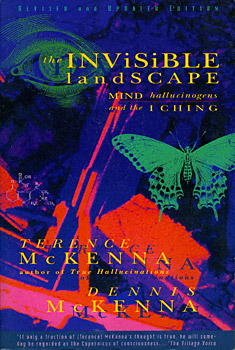
|
Following the ingestion of an enormous overdose of nineteen Psilocybe mushrooms (a "normal" dose being perhaps three to six)--plus continuous smoking of cannabis, consuming some ayahuasca that Terence had brewed up, and experimenting with prolonged vocal ululations--Dennis developed a thought-hallucination, sympathetically supported by Terence, in which he felt they both were in touch with a "Teacher" of some kind. This "Teacher" would guide them to generate a hologram that would:
"begin to broadcast the information stored in the DNA, making that data both comprehensible to thought and open to manipulation by thought. If the experiment worked, one of us in the near vicinity would be turned into a DNA radio transmitting the collective knowledge of all earthly life, all the time."Dennis fully admits that such ideas could not be described as representing "a carefully defined protocol for a scientific experiment."
"Nevertheless, this was the information that was downloaded to me by the Teacher, a recipe for constructing a hyper-dimensional artifact that would bind four dimensions into three and thereby end history. An object made of mushrooms, [ayahusca] bark, and my own DNA, welded together using the sound of my voice."While Dennis was flooded by these eschatological thought-hallucinations and furiously scribbling notes about the information he was "downloading", his brother Terence played the supportive role of maintaining contact and communication. Dennis recollects:
"In retrospect, I see how our conceits embodied a paradox of psychedelic experience. [... On] one level we understood that a molecule doesn't "contain" the trip. Rather, the trip is an interaction between a living organism and molecule's pharmacological properties. Those properties may be inherent to the drug, but the trip itself is not. [...]Here, I believe, was a crucial turning point in the development of their shared delusion, due to the brothers' inevitable conditioning and commitment to the materialist worldview, as children of their time and their place of origin. In the shamanistic worldview, the visions do not come from the drug, nor from the plant, nor even from the shaman guide who speaks or sings (whom the two brothers, in any event, did not have). The visions come from the spirits associated with the plants who communicate to the shamanic practitioner or explorer. The shaman usually has established relationships with specific plant and animal spirits through his or her practice and training, and is thus able to decode the messages and visions "coming through" (or "being downloaded") and translate them into the locally appropriate action or teaching.
We got that, sort of. But in our delusion, if that's what it was, we also embraced a conflicting view: We believed an intelligent entity resided in the drug, or at least somehow communicated to us through it. Even as we theorized about the 4-D expression of the drug--that the trip could somehow be expressed on its exterior by rotation through the fourth dimension--we were assuming on another level that a being of some sort was directing the trip.
We weren't the first or the last to make that "mistake." After all, this is very close to shamanistic views of the psychedelic experience, in which the drug speaks through a skilled practitioner."
"The human mind-brain created these experiences. At La Chorrera, the psilocybin somehow triggered metabolic processes that caused a part of our brains to be experienced not as part of the self, but as the "other"--a separate, intelligent entity that seemed to be downloading a great many peculiar ideas into our consciousness."
-- Dennis McKenna
"These substances did none of those things. The human mind-brain created these experiences. At La Chorrera, the psilocybin somehow triggered metabolic processes that caused a part of our brains to be experienced not as part of the self, but as the "other"--a separate, intelligent entity that seemed to be downloading a great many peculiar ideas into our consciousness.Actually, from my perspective--having long ago abandoned the reductionist empiricism of modern science and become a "radical empiricist" (in the sense of William James)--I would say one needs to first simply describe the experiences; then later, separately, one might speculate about their meanings and implications for our existing worldview. Easier said than done, I agree, considering the irrepressible excitement of new discoveries. You have to hold the theoretical speculations in abeyance until the intensity of the experiential download diminishes somewhat, and you can calmly reflect on the experience.
That's the reductionist perspective. Is it true? I honestly can't say, even today. It either is true, or is the alternative true, that there actually are entities in "hyperspace" that can communicate with us via something akin to telepathy when the human brain is affected by large amounts of tryptamine. That's a hypothesis worth testing, if such an experiment could ever be devised."
Certainly by now there are enough individuals in the psychedelic shamanic subculture who have had multiple experiences of intelligent communications with spirits, and who have learned, with practice, to decipher these communications and utilize them in their projects of healing or creative expression. However, in the mid-1960s our two young explorers from Colorado were just beginning their life-long journeys as psychonauts.
Over the years, I have been around dozens of people (myself included) who, as a result of ill-prepared ingestion of high-dose psychedelics, got temporarily caught in delusional thought-systems. Such systems often include profound insights, but these are over-generalized with regard to their significance. Delusions of grandeur are mixed with genuine amazement at the bewildering grandeur and magnificence of the actual world of nature all around us. There are several examples of such delusional over-generalization in the text that Dennis wrote at the time he was setting himself up for the high-dose experiment:
"In the final Stone the tryptamines act as a superconductive antenna to pick up on all cosmic energy in space and time."Not just picking up some cosmic energy, but all. Or:
"It will constitute the 4-D holographic memory of the device, and will contain and explicate the genetic history of all species."As if picking up the genetic history of one species or even one individual wouldn't be enough.
Over-generalization as part of the delusions of grandeur is perhaps a special feature of high-dose psychedelic drug experiences. I recall many times at our communal experiment at Millbrook in New York, and afterwards, being cornered by a wild-eyed hippie wanting to impart the Ultimate Cosmic Secret he had just been granted on his trip, which he was sure that everyone would appreciate for its earth-shattering profundity.
Receiving such visions does seem of overwhelming importance. And it is, at least to the individual concerned. Others, like family members or professionals, may not appreciate the cosmic significance of the vision/hallucination and are more likely to be alarmed by the tenuous nature of the individual's connections to ordinary reality. Visionaries are notorious for appearing to others like madmen.
As a psychologist, I do not believe that what the brothers experienced was schizophrenia of either the Paranoid or the Disorganized variety. The latter is characterized by fragmented ideation and inability to think rationally. What the McKennas experienced was a glimpse into what shamans would call the "spirit world", and what they called "hyperspace". There is an inexhaustible vastness of other dimensions in our universe that are always there but only accessible in special states of consciousness and/or through shamanic or yogic practice, or specific instrumentation.
And yes, their glimpse was fragmentary. And yes, they were unprepared. And yes, they had no ready-made language to describe what they found. Explorers never do. These visions of non-ordinary reality can only be communicated if one has access to a worldview and a consensual language to describe them. The brothers McKenna did not have either at the time of their "experiment", although they have both contributed significantly since then to creating such an expanded worldview--Terence through his imaginative and inspiring speculations, Dennis through his solid scientific investigations into the neurochemical effects of ethnobotanical medicines.
"The ravings of a madman, I'll grant that. And yet, there is also poetry here, and beauty, and a longing for redemption. What I expressed is not that different from the vision articulated by the most compassionate and beautiful of the world's religions: the universe will not achieve perfection until all beings have achieved enlightenment. Isn't that what I'm saying?"
-- Dennis McKenna
"The ravings of a madman, I'll grant that. And yet, there is also poetry here, and beauty, and a longing for redemption. What I expressed is not that different from the vision articulated by the most compassionate and beautiful of the world's religions: the universe will not achieve perfection until all beings have achieved enlightenment. Isn't that what I'm saying? No doubt there is messianic delusion here; indeed, in passages a bit further on in that text I discuss my role as cosmic Antichrist. But there is also a deep wish for healing, not only of myself but of the universe. Our mother had been dead less than six months. I have to believe that much of what happened to us at La Chorrera was linked to that tragic event. So overwhelmed were we by the sense of loss, and of guilt, we were ready to tear space and time apart in order to reverse that cosmic injustice."Over the next couple of weeks Dennis put his fragmented identity-programs back into a functional order, while his brother Terence began obsessively constructing his own metaphysical system that later become known as Timewave Zero. The brothers' companions could see only psychosis and wanted to bring Dennis to a psychiatric facility--no small task considering they were in the Amazon jungle. Dennis writes he was "grateful to Terence for resisting the pressure to leave La Chorrera. [Terence] insisted that whatever was happening to us be allowed to unfold in its own time and on its own terms [...], and that there was no need for intervention beyond making sure that I didn't wander off or hurt myself."
Terence's intuitive understanding of the need to let the fragmented self-system of his brother find its own way back to center and to wholeness was consonant with the teachings of psychiatrists like Ronald Laing, Stanislav Grof, John W. Perry, and others who have championed the idea that some forms of so-called "psychosis" can be understood as the psyche's own natural healing journey, which is best supported by others, and not cut short by psychiatric medications.
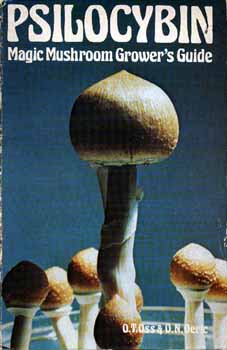
|
Returning to Mainstream Reality: The Aftermath of La Chorrera
The brothers eventually took different career paths. Dennis went on to pursue graduate, doctoral, and post-doctoral studies in plant chemistry and pharmacology, published research on the pharmacology of Amazonian psychoactive plants, and worked (still does) as a research consultant for the pharmaceutical and herbal industry. Terence, more of an auto-didact, devoted himself to writing and became a much sought-after speaker on the psychedelic lecture circuit. But immediately after returning to the United States from La Chorrera, the McKennas were more convinced than ever of the value of psilocybin-containing mushrooms. Using pseudonyms, and in collaboration with Kathleen Harrison as illustrator, they followed up their book The Invisible Landscape by producing a practical an instruction guide for indoor mushroom cultivation.In the foreword to Psilocybin: Magic Mushroom Grower's Guide, Terence described a vision he received--perhaps the core and guiding vision of his life--of the interstellar origin of the mycelial nets, the true body of the mushrooms, which he proposed maintain a "vast historical archive of the career of evolving intelligence on many worlds". The mycelial networks seek habitable planets, he was told, where they can enter into symbiotic communication and exchange with intelligent species, providing those species with access to the "community of galactic intelligence." The notion of the true form of the mushroom being the mycelial nets and the emphasis on symbiotic interactions of fungi with other species are points consistent with current scientific understanding of fungal evolution, as formulated in the work of Paul Stamets and Lynn Margulis. The idea of extraterrestrial origin is uniquely and provocatively Terence McKenna, emissary from the world of entheogenic fungi.
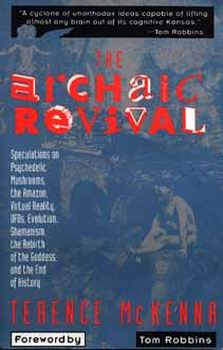
|
"[... The] mushroom was a species that did not evolve on earth. Within the mushroom trance, I was informed that once a culture has complete understanding of its genetic information, it reengineers itself for survival. The Stropharia cubensis mushroom's version of reengineering is a mycelial network strategy when in contact with planetary surfaces and spore-dispersion strategy as a means of radiating throughout the galaxy. [... The] other side does seem to be in possession of a huge body of information drawn from the history of the galaxy. [...] The Stropharia cubensis mushroom, if one can believe what it says in one of its moods, is a symbiote, and it desires ever deeper symbiosis with the human species. It achieved symbiosis with human society early by associating itself with domesticated cattle and through them human nomads."He later cheerfully argues against his own thesis of extraterrestrial origin, though, when he goes on to say that he has recently come to suspect "that the human soul is so alienated from us in our present culture that we treat it as an extraterrestrial. To us the most alien thing in the cosmos is the human soul."
I personally find the thesis that extraterrestrial sources of vast intelligence might be communicating to the human species via entheogenic mushrooms (and/or plants) quite plausible and worthy of further investigation. It is consistent with the fact that interest in UFOs and extraterrestrial culture and contact has been growing tremendously in the second half of the twentieth century, in tandem with other movements of consciousness expansion, such as psychedelics, shamanism, spiritual practices, and higher states of consciousness. Harvard psychiatrist John Mack, who made an intensive study of the UFO abduction experience, noted in his book Passport to the Cosmos that reported contact and communication with alien intelligences is widespread and almost taken for granted in societies with living shamanic traditions. The notion that experiences with Amazonian hallucinogenic vines could also facilitate or induce visions of extraterrestrial visitors and space-ships is supported by the art of Pablo Amaringo, a Peruvian ayahuasquero who painted hundreds of his visionary experiences, including some that featured extraterrestrial crafts.
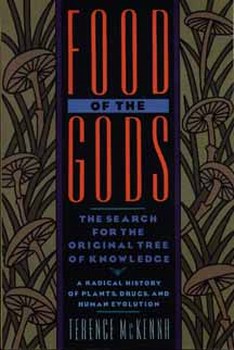
|
Data potentially in favor of the idea that mind-expanding plants may have played some role (if not the only one) in the evolution of language includes: (1) laboratory evidence that psilocybin and other psychedelics lower sensory thresholds; i.e., they heighten acuity of sense perception, which could confer a direct adaptive advantage; (2) studies of brain areas activated during psilocybin states show major activity in the frontal cortex, the area most involved in processing complex perceptions and thoughts; (3) evidence from subjective accounts suggests that psychedelic mushrooms may heighten cognitive awareness and linguistic fluidity; consider, for example, the chants of the Mexican Mazatec curandera María Sabina; and (4) heightened problem-solving ability, with adaptive advantages, is also suggested by the effective use of psychedelic drugs in psychotherapy and shamanic divination.
In Food of the Gods, Terence ranges far and wide through history, anthropology, and around the globe with his review of sacred mind-expanding substances. He re-examines R. Gordon Wasson's hypothesis that soma, a mysterious substance deified in the Vedas, was basically the Amanita muscaria mushroom cult, imported from Central Asia. Though historian of religion Mircea Eliade, who wrote a masterful overview of shamanism, considered the use of psychoactive plants a degenerate form of religious practice, Wasson--on the basis of his experiences in Mexico with the Psilocybe mushroom and his beliefs about soma--took the opposite view. Wasson held that all religious experience was originally induced by psychoactive plants, and that the practices of yoga developed in India were substitute methods created when the mushroom was no longer available to the ecstatic visionaries. Terence came down on the side of Wasson, but speculated that soma was the Psilocybe mushroom, not the fly agaric, for the main reason that the latter is only mildly psychedelic; however, apart from some ambiguous mushroom-shaped stones, no evidence has been found for either mushroom species existing in India.
It may be impossible to ever settle this question in the history of religion completely. But that some psychedelic plants may have played a role in the origins of some religious traditions, as well as some aspects of language (for example, bardic poetry) seems to me both plausible and probable.
"The contention here is that the rise of language, partnership society, and complex religious ideas may have occurred not far from the area where humans emerged--the game-filled, mushroom-dotted grasslands and savannahs of tropical and subtropical Africa. There the partnership society arose and flourished; there hunter-gatherer culture slowly gave way to domestication of animals and plants. In this milieu the psilocybin-containing mushrooms were encountered, consumed, and deified. Language, poetry, ritual, and thought emerged from the darkness of the hominid mind."
-- Terence McKenna
"The contention here is that the rise of language, partnership society, and complex religious ideas may have occurred not far from the area where humans emerged--the game-filled, mushroom-dotted grasslands and savannahs of tropical and subtropical Africa. There the partnership society arose and flourished; there hunter-gatherer culture slowly gave way to domestication of animals and plants. In this milieu the psilocybin-containing mushrooms were encountered, consumed, and deified. Language, poetry, ritual, and thought emerged from the darkness of the hominid mind."
Concluding Remarks
Revisiting the ideas and writings of the McKenna brothers brought to my mind an intriguing comparison with the life and times of another pair of pioneering scientist-scholar brothers from the early nineteenth century: Alexander and Wilhelm von Humboldt. Alexander von Humboldt was a naturalist and explorer who traveled extensively in Latin America, describing for the first time, in over twenty illustrated volumes, the biogeography, flora, and fauna of the region. Wilhelm von Humboldt was a diplomat, educator, and linguist, who made important contributions to the philosophy of language as well as the theory and practice of education in Prussia, the brothers' country of origin.
The McKenna brothers also have made significant contributions: to expanding our scientific knowledge of mind-assisting plants, fungi, and substances; to the flora and fauna of inner-space geography; and to the new languages and concepts inevitably needed if we wish to understand the bewildering and fascinating world of psychoactive substances.- A similar ayahuasca-inspired insight has been described by the anthropologist Jeremy Narby; see: The Cosmic Serpent: DNA and the Origins of Knowledge.
- McKenna, D. 2012. The Brotherhood of the Screaming Abyss: My Life with Terence McKenna. St. Cloud, MN: North Star Press.
- McKenna, D.J. and McKenna, T.K. 1975. The Invisible Landscape: Mind, Hallucinogens, and the I Ching. NY: The Seabury Press.
- Oss, O.T. and Oeric, O.N. 1976. Psilocybin: Magic Mushroom Grower's Guide. Berkeley, CA: And/Or Press.
- McKenna, T. 1991. The Archaic Revival: Speculations on Psychedelic Mushrooms, the Amazon, Virtual Reality, UFOs, Evolution, Shamanism, the Rebirth of the Goddess, and the End of History. New York, NY: HarperCollins.
- McKenna, T. 1992. Food of the Gods: The Search for the Original Tree of Knowledge: A Radical History of Plants, Drugs, and Human Evolution. New York, NY: Bantam Books.
- v1.0 - Mar 6, 2013 - Published on Ralph Metzner's Blog.
- v1.1 - Mar 21, 2013 - Edited for publication on Erowid.org; permission granted by Ralph Metzner.

